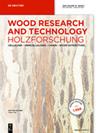立地质量影响人工林带松的树形、心材含量和单板产量
IF 1.6
3区 农林科学
Q2 FORESTRY
引用次数: 0
摘要
由于南非原生林的木材衍生产品有限,人工林物种被引入南非。目前,墨西哥松是该国种植最广泛的针叶树种。为了研究生长环境对该树种木材和加工特性的影响,在南非Mpumalanga建立了覆盖广泛土壤地质和海拔的样地,每20年轮作一次。还测定了样地的温度和季节降雨量。从地块中随机选择样本树,并在胶合板工厂进行处理,以确定单板的恢复和质量。与生长在低草原地区常见的白云岩和页岩土壤上的树木相比,生长在花岗岩土壤上的树木,年最高温度更高,降雨量更少,在高草原地区发现的树木,表现出更好的树木大小,细细度和体积生长。来自Lowveld树木的贴面有更多的裂缝,这在很大程度上与缺陷有关。与较小的树木相比,较大的树木也有较大的体积心材百分比和较小的活树冠。高原树木比低地树木有更大的净贴面恢复和更好的贴面质量。在普马兰加森林地区,土壤地质、海拔和气候之间存在很强的相关关系。虽然发现树木形态和木材性质随土壤地质和海拔的不同而不同,但这些差异主要与气候有关,而不是与土壤性质有关。这些发现强调了在分析特定地点的生长条件对树木生长和形态的影响时忽视气候或土壤特性所带来的缺陷。本文章由计算机程序翻译,如有差异,请以英文原文为准。
Site quality impacts tree form, heartwood content and veneer production of plantation-grown Pinus patula
Abstract Plantation forest species were introduced into South Africa due to limited availability of native forests for wood-derived products. Currently, the Mexican pine species, Pinus patula, is the most widely planted softwood species in the country. To study the effect of growth environment on wood and processing properties for the species, sample plots were established in a 20-year rotation covering a wide range of soil geologies and altitudes in Mpumalanga, South Africa. Temperature and seasonal rainfall were also determined for the sample plots. Randomly selected sample trees were harvested from the plots and processed at a plywood plant to determine veneer recovery and quality. Trees grown on sites composed of granite soils, with higher annual maximum temperatures and less rainfall, found in the Highveld region, displayed superior tree size, slenderness, and volume growth, compared to trees grown on dolomite and shale soils common to the Lowveld region. Veneer derived from Lowveld trees had more splits which were largely related to defects. Larger trees also had a greater percentage volumetric heartwood and a smaller live crown, compared to smaller trees. Highveld trees had greater net veneer recovery and produced better quality veneer than trees grown on the Lowveld. In the Mpumalanga forestry region, strong co-relatedness exists between soil geology, altitude, and climate. Although tree form and wood properties were found to differ with varying soil geology and altitude, these differences were primarily related to climate rather than soil properties. These findings highlight the pitfalls associated with neglecting either climate or soil properties when analysing site-specific growing conditions on tree growth and form.
求助全文
通过发布文献求助,成功后即可免费获取论文全文。
去求助
来源期刊

Holzforschung
工程技术-材料科学:纸与木材
CiteScore
4.60
自引率
4.20%
发文量
83
审稿时长
3.3 months
期刊介绍:
Holzforschung is an international scholarly journal that publishes cutting-edge research on the biology, chemistry, physics and technology of wood and wood components. High quality papers about biotechnology and tree genetics are also welcome. Rated year after year as one of the top scientific journals in the category of Pulp and Paper (ISI Journal Citation Index), Holzforschung represents innovative, high quality basic and applied research. The German title reflects the journal''s origins in a long scientific tradition, but all articles are published in English to stimulate and promote cooperation between experts all over the world. Ahead-of-print publishing ensures fastest possible knowledge transfer.
 求助内容:
求助内容: 应助结果提醒方式:
应助结果提醒方式:


